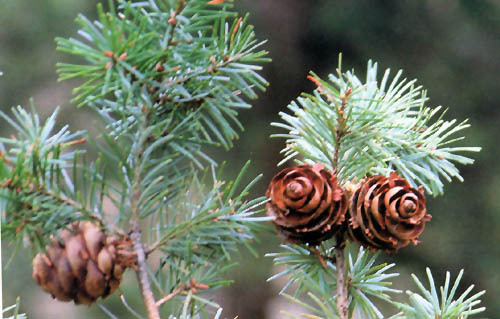Pseudotsuga forrestii, first described by Craib in 1919, is commonly known as æ¾œæ²§é»„æ‰ (lan cang huang shan) in the Chinese language. It is synonymous with P. sinensis var. forrestii (Craib) Silba 1990.
Description. Pseudotsuga forrestii is an evergreen coniferous tree which grows to 120 feet (40 m) tall with a trunk diameter of up to 32 inches (80 cm) at breast height. Its bark is dark brown-gray, rough, and deeply fissured longitudinally. Branchlets are pale yellow or greenish yellow at first , becoming reddish brown when dry, then light brown or brownish gray in 2nd or 3rd year, glabrous or pubescent. Leaves pectinately arranged, subsessile, linear, 1.1 to 2.2 inches (2.8-5.5 cm) long by 0.05 to 0.08 inch (1.3 - 1.8 mm) thick, with a cuneate base , and emarginate apex. Seed cones are ovoid, 2 to 3.2 inches (5 - 8 cm) long by × 1.6 to 2.2 inches 4 - 5.5 cm) wide. Seed scales at middle of cones suborbicular or rhombic-orbicular, 1 to 1.4 inches (2.5 - 3.5) long by × 1.2 to 1.6 inches (3 - 4 cm) wide, abaxially glabrous, with a cuneate-orbicular base. Bracts are obviously longer than seed scales, and are reflexed with a 0.24 to .05 inch (6 - 12 mm) lanceolate cusp, and narrowly triangular ca. 0.12 inch (3 mm) lateral lobes. Seeds are light brown, irregularly dark spotted, triangular-ovoid, slightly depressed, glabrous adaxially with an obliquely ovate wing. Seed matures in October.
Distribution. This species is native to China - Yunnan province, where it is found in the mountains at 7,700 to 10,500 feet (2,400 - 3,300 m) elevation.
